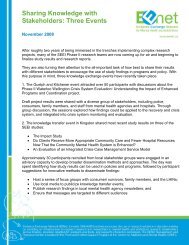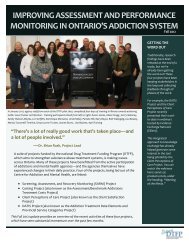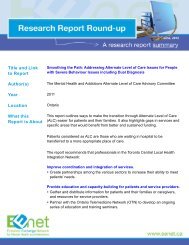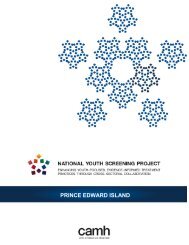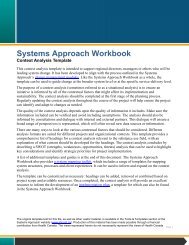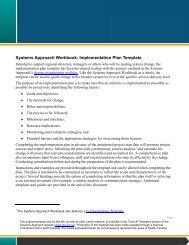Implementation of Early Psychosis Intervention Program ... - EENet
Implementation of Early Psychosis Intervention Program ... - EENet
Implementation of Early Psychosis Intervention Program ... - EENet
You also want an ePaper? Increase the reach of your titles
YUMPU automatically turns print PDFs into web optimized ePapers that Google loves.
52o Using social media and youth friendly strategies.o Staff using their own vehicles to transport clients.o Having a safety strategy in place for staff working in the community.o Fostering interagency collaboration to access spaces to meet with clients in the communityand facilitate referrals.What would help programs to conduct proactive outreach with clients:o More youth-friendly program setting (noted by 30%).o More supportive organizational policies that allow more flexible communication (e.g., phone,email) and staff transport <strong>of</strong> clients.o Developing written procedures for missed appointments or situations when the client refusescare – only ¼ <strong>of</strong> sites currently have these in place.o Having staff safety protocols in place when working in the community.o Additional staffing, lower caseloads, and resources to support travel, especially in more ruralsettings.3. Anti-psychotic medication treatmentStandard 3 indicates use <strong>of</strong> low dose, slow increment anti-psychotic medication when clinicallyindicated as a first line therapy to treat psychosis, and periodical psychiatric re-assessments.Summary <strong>of</strong> Results:o Sites reported a very high level <strong>of</strong> implementation, with 94% able to use low dose, slowincrement anti-psychotic medication as first line <strong>of</strong> therapy ‘most <strong>of</strong> the time’.o Most sites also reported high portions <strong>of</strong> clients (90% or more) on anti-psychoticmedications, although rates were somewhat lower for small programs (76%).o Many sites reported following protocol items for side effects monitoring (e.g., blood workand metabolic monitoring). However, implementation was lower in community agencysponsored and small programs.o Less than half <strong>of</strong> sites have formal written procedures for anti-psychotic medicationmonitoring.o While implementation was high, about half <strong>of</strong> sites reported that better access to psychiatryand primary care would help support efforts to implement this Standard.o Cost <strong>of</strong> medications was an <strong>of</strong>ten cited barrier to use - improving drug benefit plans throughexisting programs such as ODSP and Trillium was suggested.



